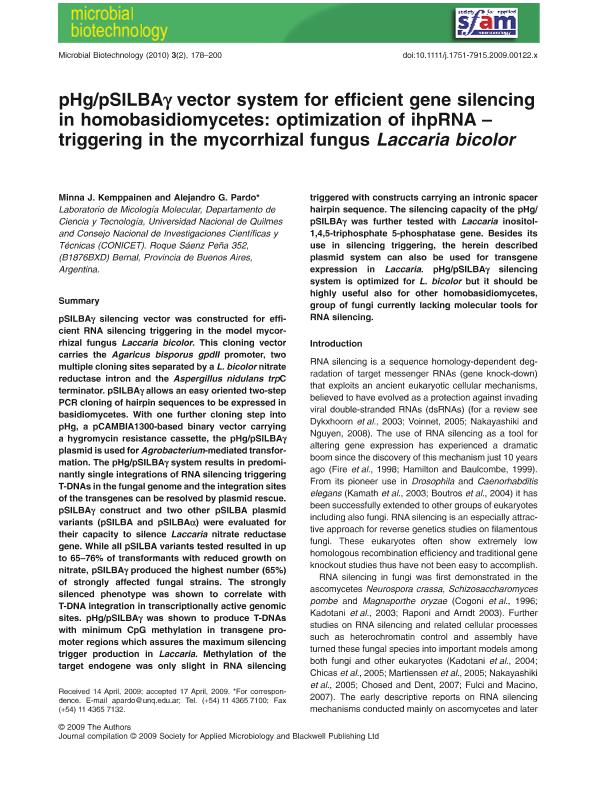Mostrar el registro sencillo del ítem
dc.contributor.author
Kemppainen, Minna Johanna

dc.contributor.author
Pardo, Alejandro Guillermo

dc.date.available
2023-02-02T13:03:11Z
dc.date.issued
2010-03
dc.identifier.citation
Kemppainen, Minna Johanna; Pardo, Alejandro Guillermo; pHg/pSILBAγ vector system for efficient gene silencing in homobasidiomycetes: Optimization of ihpRNA - Triggering in the mycorrhizal fungus Laccaria bicolor; Blackwell Publishing; Microbial Biotechnology; 3; 2; 3-2010; 178-200
dc.identifier.issn
1751-7915
dc.identifier.uri
http://hdl.handle.net/11336/186613
dc.description.abstract
pSILBAγ silencing vector was constructed for efficient RNA silencing triggering in the model mycorrhizal fungus Laccaria bicolor. This cloning vector carries the Agaricus bisporus gpdII promoter, two multiple cloning sites separated by a L. bicolor nitrate reductase intron and the Aspergillus nidulans trpC terminator. pSILBAγ allows an easy oriented two-step PCR cloning of hairpin sequences to be expressed in basidiomycetes. With one further cloning step into pHg, a pCAMBIA1300-based binary vector carrying a hygromycin resistance cassette, the pHg/pSILBAγ plasmid is used for Agrobacterium-mediated transformation. The pHg/pSILBAγ system results in predominantly single integrations of RNA silencing triggering T-DNAs in the fungal genome and the integration sites of the transgenes can be resolved by plasmid rescue. pSILBAγ construct and two other pSILBA plasmid variants (pSILBA and pSILBAα) were evaluated for their capacity to silence Laccaria nitrate reductase gene. While all pSILBA variants tested resulted in up to 65-76% of transformants with reduced growth on nitrate, pSILBAγ produced the highest number (65%) of strongly affected fungal strains. The strongly silenced phenotype was shown to correlate with T-DNA integration in transcriptionally active genomic sites. pHg/pSILBAγ was shown to produce T-DNAs with minimum CpG methylation in transgene promoter regions which assures the maximum silencing trigger production in Laccaria. Methylation of the target endogene was only slight in RNA silencing triggered with constructs carrying an intronic spacer hairpin sequence. The silencing capacity of the pHg/ pSILBAg was further tested with Laccaria inositol-1,4,5-triphosphate 5-phosphatase gene. Besides its use in silencing triggering, the herein described plasmid system can also be used for transgene expression in Laccaria. pHg/pSILBAγ silencing system is optimized for L. bicolor but it should be highly useful also for other homobasidiomycetes, group of fungi currently lacking molecular tools for RNA silencing.
dc.format
application/pdf
dc.language.iso
eng
dc.publisher
Blackwell Publishing

dc.rights
info:eu-repo/semantics/openAccess
dc.rights.uri
https://creativecommons.org/licenses/by-nc-sa/2.5/ar/
dc.subject
Gene silencing
dc.subject
Homobasidiomycetes
dc.subject
Laccaria bicolor
dc.subject
Ectomycorrhiza
dc.subject.classification
Otras Ciencias Biológicas

dc.subject.classification
Ciencias Biológicas

dc.subject.classification
CIENCIAS NATURALES Y EXACTAS

dc.title
pHg/pSILBAγ vector system for efficient gene silencing in homobasidiomycetes: Optimization of ihpRNA - Triggering in the mycorrhizal fungus Laccaria bicolor
dc.type
info:eu-repo/semantics/article
dc.type
info:ar-repo/semantics/artículo
dc.type
info:eu-repo/semantics/publishedVersion
dc.date.updated
2023-01-31T17:38:48Z
dc.journal.volume
3
dc.journal.number
2
dc.journal.pagination
178-200
dc.journal.pais
Reino Unido

dc.description.fil
Fil: Kemppainen, Minna Johanna. Universidad Nacional de Quilmes. Departamento de Ciencia y Tecnología. Laboratorio de Micología Molecular; Argentina. Consejo Nacional de Investigaciones Científicas y Técnicas; Argentina
dc.description.fil
Fil: Pardo, Alejandro Guillermo. Universidad Nacional de Quilmes. Departamento de Ciencia y Tecnología. Laboratorio de Micología Molecular; Argentina. Consejo Nacional de Investigaciones Científicas y Técnicas; Argentina
dc.journal.title
Microbial Biotechnology
dc.relation.alternativeid
info:eu-repo/semantics/altIdentifier/url/https://onlinelibrary.wiley.com/doi/10.1111/j.1751-7915.2009.00122.x
dc.relation.alternativeid
info:eu-repo/semantics/altIdentifier/doi/http://dx.doi.org/10.1111/j.1751-7915.2009.00122.x
Archivos asociados
